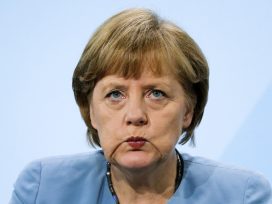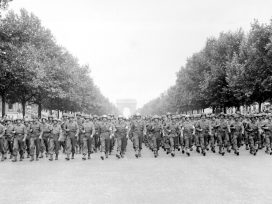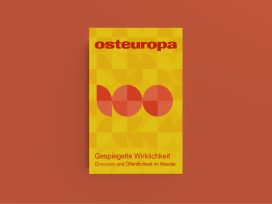A spate of violent assaults by “migrant” youths on “native” Germans at the end of 2007 has given impetus to theories of a “cultural clash” between minorities and the majority in Germany and sparked off a bout of victim-identification in parts of the press. The anti-German remarks made by the offenders (including “pork eater”) supposedly distinguished the attacks from everyday incidents of violence and, it was suggested, provided evidence of a rise in anti-German xenophobia. Yet, while the lack of integration among urban male youths with migration backgrounds in Germany is an increasingly serious problem, insofar as non-integration is indicated by rates of criminal re-offending, statistics show no difference between “migrant” youths and “native” youths within the same social-economic bracket. And while the incidents may well constitute evidence that “anti-German xenophobia” – which could just as well be called social hatred – accompanies an increasing failure of integration on the part of male migrant youths, it is by no means self-evident to infer from this the existence of a “cultural clash”.
The impression of alarmism increases when one compares the recent discourse with the discussion of far-right racist violence, one that has been ongoing in Germany since the early 1990s. Here, while the seriousness of the causes and effects of rightwing violence has been acknowledged, a consensus has also been reached that majority German society is by no means undergoing a “fascist revival”. There has been an attempt to understand racially motivated far-right violence in terms of socialization: to engage with neo-Nazi xenophobia on the basis that it is the result of a failure of education, for example. Why, then, in the case of the migrant youth violence, were some parts of the media willing to follow the offenders’ lead in “culturalizing” the debate? Why was a discourse of cultural difference with exaggerated implications of “civil war” preferred over a discussion of failed integration?
On one hand, the controversy conformed to the anti-Islamic climate prevalent throughout Europe and beyond. On the other, it typified a specifically German discourse on the relation between minorities and the majority. The fact that the victim belonged to a perceived “majority” was central to the incidents’ affective impact. A similar pattern of victim-identification was also strongly evident in last year’s controversy over the release from prison of former members of the RAF (Rote Armee Fraktion). In both cases, victim-identification was heavily orchestrated by the media and fed directly into political campaigns targeting the majority’s sense of embattlement. How, then, does this exaltation of the “victim” operate and what are its implications?
The feuilletons identify the enemy
The assault by two youths on a pensioner in Munich on 30 December 2007, which was caught on CCTV and instantly found its way onto television and the Internet, provoked particular media indignation. However, only when the cultural editor of Die Zeit, Jens Jessen, suggested that the incident was a case of the straw that broke the camel’s back, did the mudslinging break out in the feuilletons. The provocation for the assault – the victim had demanded that the youths stop smoking on the underground – belonged, Jessen argued in a video blog on his paper’s website, to an “endless chain of similar admonitions”. The problem, Jessen said, was not violent migrant youths but rather that “there are too many patronizing German pensioners who make foreigners’ lives hell, as well as the lives of many Germans”.
Frank Schirrmacher, editor of the Frankfurter Allgemeine Zeitung and prominent conservative voice, took the bait and in hyperbolic style announced that: “The taboo that bans speaking about foreign youth criminality except in connection with youth criminality in general is history.” The police’s attempt to charge the offenders for incitement to racism failed on the basis that it had not been directed at a “part” of the population: “Germans”, as the majority, were judged not to be “a part”. Schirrmacher:
Aren’t they? They are the part that stands for the whole: namely a tradition that does not allow that radical ideologies and racist attacks taking place in its midst go unpunished. […] When terrorism declares the majority to be the enemy, the state responds by taking legal measures. […] Entailed in the clarity required by the state is that one speaks out about that fact that the mix of youth criminality and Islamic fundamentalism is what today potentially comes closest to the murderous ideologies of the twentieth century.
The next day, excerpts of Schirrmacher’s article were reprinted in Springer-owned Bild-Zeitung, under the headline (also a quote): “They have identified the enemy”. At first glance, one was not sure who “they” referred to – migrant youths or the media. It became clear, however, with Bild-Zeitung columnist Franz-Josef Wagner’s suggestion that Jessen be sent to a correction camp; this vicious humour was sanctioned, as it were, by the opinion of the editor of high-brow FAZ. It went widely uncommented upon that correction camps were part of the National Socialist penal system from 1940 onwards.
Next to enter the fray was Thomas Schmid, cultural editor of die Welt, the “intelligent sister-paper” of Bild-Zeitung, who berated Jessen for “making the victim, the pensioner, into the perpetrator. And, conversely, declaring the perpetrators to be unfortunate outsiders whom one ought not to condemn or deplore but understand.” Jessen, wrote Schmid, saw in the pensioner the “‘German Spießer” – roughly translated as narrow-minded petit-bourgeois and small-time Nazi – a traditional hate figure for the Left. Schmid, himself a former ’68er, omitted to mention Schirrmacher’s own invocation of Nazism and instead wrote about:
[…] the growing number of young male foreigners that can make life in the city wearisome. […] The problem has arisen because they have what one calls a ‘migration background’ and because they see German society from the outside, with foreign eyes. Many don’t want to belong, don’t want to become an active part. They represent something like an existential, almost physical dissent to the social majority. And for that reason, the rules that are valid here remain foreign to them.
The debate about migrant youth violence had also made its way into the regional election campaign running at the time in Hessen. CDU candidate Roland Koch seized upon the issue as a way to woo conservative voters disappointed by the perceived “shift to the left” being taken by the CDU at the federal level. Undeterred by the ridicule his call for a burka ban in schools had previously earned him (it was pointed out that not a single school pupil in Hessen actually wears a burka), he now opted for the role of taboo breaker:
For many centuries there has exited a Christian-Western culture in Germany. Whoever doesn’t stick to our rules is out of place here. He can’t expect that we meet him halfway. The basic rules of respectability and behaviour are non-negotiable.
Koch’s plea for quicker deportation for non-German offenders was published in Bild-Zeitung; yet when, in the same paper, he suggested that “in extreme cases” parts of youth law could be applied to offenders under the age of 14, the public began to react against his immoderate tone. Critics detected in a CDU slogan warning voters of the possibility of an SPD coalition with the Green party and the Left Party (Linkspartei) an attempt to link the “foreign sounding” names of the opposition politicians with political sabotage. Koch’s negative campaign backfired: the CDU made severe losses in Hessen though still managed to beat the SPD by a narrow margin.
RAF redux
Koch’s attempt to convert negative public feeling generated by the youth violence debate into votes was similar in kind to CDU/CSU politicians’ attempt in 2007 to tap into the sense of injustice felt by a broad section of the German public faced with the prospect of the early release from prison of former-RAF members Brigitte Mohnhaupt and Christian Klar.
Of course, it is nothing new for politicians to manipulate public feeling on law and order issues; likewise, in the age of spin, the collusion of politics and media can be taken as given. Nevertheless, these two cases are instructive insofar as they suggest how such collusion can undermine the neutrality of political and legal institutions. As the migrant youth violence debate indicated, shared interests between media and politics can overlap onto the electoral process, introduce a lack of transparency, and enable the media to act as kingmakers. Furthermore, commercial media prerogatives encourage populist political campaigns that appeal to and exacerbate racism. In the case of the debate on RAF prisoners, a heavily one-sided political campaign waged by the media while the decision on the release of the RAF prisoners was still pending jeopardized the perceived independence of the judiciary and that of its highest representative in Germany, the federal president.
Writing in 2000 on the media afterlife of German leftwing terrorism, historian Wolfgang Kraushaar commented that: “The state used to need the RAF in order to prove itself and its apparatus. Now it seems that the mass media needs the negative aura of the RAF.” Last year’s saturation of RAF-related topics in the German media, the thirtieth anniversary of the escalation of leftwing violence known as the deutsche Herbst, suggested that the public appetite for familiar facts, faces, and biographies, along with the media’s willingness to cater to it, had, if anything, increased since Kraushaar’s observation. What processes were at work that made possible a situation in which the public (or at least a large enough sector of it to make it worth the media’s while) was perceived to have an unslakeable thirst for the re-narration of the story of the RAF?
The “sympathizer” (Sympathisant) is a crucial figure here. As widely employed during the “the red decade” from 1967 to 1977, it denotes those who, while not advocating violence, nevertheless approved of terrorism’s “noble core”. One famous “sympathizer” was Heinrich Böll. In 1972, Böll published an article in der Spiegel in which he condemned the Bild-Zeitung‘s hate campaign towards the RAF and the extra-parliamentary Left as “inflammation, lies, filth” and criticized politicians’ practice of giving interviews to the newspaper as “naked fascism”. Böll was from then on branded as a “sympathizer”; during the kidnapping of employer’s association chairman Hanns-Martin Schleyer in September 1977, CDU politician Kurt Biedenkopf called Böll “a particularly problematic sympathizer”, saying that “The state’s real problem is not the terrorists themselves, but the […] so-called intellectuals and leftwing liberals.”
Hostility towards “the silent reserve army of terrorism” (die Welt) reached a climax in April 1977, when a student newspaper published an article in which the anonymous author expressed his “silent joy” over the murder by the RAF of Federal Prosecutor Siegfried Buback. The article was promptly republished in other newspapers for “the sake of discussion”, as well as in a book edited by a group of university professors, who were subsequently denounced as “cheerleaders of terrorism”. A range of charges, including the condoning of criminal offences, the sullying of the memory of the dead, and inciting violence, was brought against those who disseminated the article. This over-reaction demonstrated the tendency on the part of the press and judiciary to fail to distinguish between “accomplices” and “sympathizers”. Nevertheless, while the extra-parliamentary Left was not unjustified in feeling itself to be demonized, for the large part it was unable to reflect upon its own mechanisms of projection upon leftwing terrorism. From the start, the RAF served a vicarious function for the vast majority of sympathizers, for whom approval of violence was never anything else than revolutionary bravado.
The label “sympathizer” has arguably remained in the collective lexicon to denote anyone who sees in a RAF terrorist (“former” or otherwise) anything other than a perpetrator – as a subject of the law, for example. And, of course, a perpetrator requires a victim. As historian Martin Sabrow has remarked, the way in which the discussion of the ’68 movement and leftwing terrorism has altered over the decades is in its emphasis on victims: “Whoever as a member of the extra-parliamentary opposition called for […] ‘counter-violence against the dominant class’ did so in a horizon of thought and action far more strongly based on the categories of war and resistance than today’s – and at the same time, almost inconceivably more loosely based on concepts of suffering and victimhood.” Someone who feels “sympathy” (Mitleid) for the “victim” of the terrorist perpetrator thus becomes the counterpart to the terrorist “sympathizer”. And so it was that no television debate on RAF prisoners was complete without the presence of a “victim” – as if analysis lacked validity without a physical reminder of suffering.
Oddly, the sense that “words are not enough” recalls the Left’s own stricken conscience at the time of Ulrike Meinhof’s transformation from journalist to terrorist. Meinhof’s daughter Bettina Röhl has said of her: “Like many socially engaged people, she believed she had to make herself the same as the unfortunate, that she had to feel their pain on her own body in order to reduce the suffering.” After the arrest of Meinhof and other members of the RAF core group in June 1972, the central question for sympathizers became the treatment of “political prisoners”, an image adeptly cultivated by the RAF themselves. Of her experience of solitary confinement, Meinhof commented that: “The political term for death row, Cologne, I’m saying quite clearly, is gas. My Auschwitz fantasies in there […] were realistic.” The “phantasm of extermination prison” became the central element of sympathy-building and, via “torture committees” established nationwide, a means of recruitment for subsequent generations of the RAF. For many, the death of RAF prisoner Holger Meins after a hunger strike in 1975 was the moment of political conversion; the resemblance between images of the emaciated Meins and those of concentration camp victims made him a fundamental object of identification.
Nevertheless, thirty years on, the mantle of the victim had unequivocally been passed over to the victims of the RAF. In Anne Siemens’s best-selling collection of interviews with victims’ family members, the daughter of murdered banker Jürgen Ponto asserted that: “Whoever is a victim can never become a former victim. But the perpetrators are today often referred to as ‘former terrorists’. […] I don’t know of any former murderers, nor of any former child abductors. But all those who were in the RAF and now live back in our society call themselves ‘former-terrorists'”. The fact that the term “former terrorist” is not congruent with “former perpetrator” (how should rehabilitative justice function otherwise?), and that no one was claiming that it was – was irrelevant. What Corinna Ponto really meant was: We, as victims, have been ignored for too long; it is time that the authority of our suffering is acknowledged. The victims were to enter the discourse on the RAF on two fronts: first, as implied by Siemens’s book, on a cognitive level – to “understand the RAF” now meant to understand the suffering of its victims; second, as Corinna Ponto’s statement demonstrated, on the legal-ethical level, in this case, as one, if not the factor on which to base a decision on whether to show lenience towards RAF prisoners.
Certainly, claims that the victims of the RAF have until now received short shrift, both in the media and academia as well as in terms of financial compensation and psychological counselling from the state, are well founded. Furthermore, the tendency to focus on the RAF at the expense of their victims has resulted in a discourse that largely moves within the terms of reference used by the RAF itself. What was striking in the debate, however, was the symbolic weight attached to the suffering of individual victims. Via the media, the victims had become so omnipresent that it was hard to avoid the impression that their suffering was being presented as a synecdoche for the suffering inflicted by the RAF on German society at large. It was as if that part of the German public that sympathized with the victims was collectively appealing to a sense of justice higher than that offered by the law for an injury inflicted upon it as a whole.
This emphasis on the victims far outweighed the acknowledgement that Mohnhaupt and Klar were entitled to be considered for early release, like all prisoners serving life sentences, regardless whether they show remorse. After a psychologist’s report found that Mohnhaupt no longer posed a threat to the public, her parole was approved by justice minister Brigitte Zypries (SPD). On the day of her release, CSU leader Edmund Stoiber called it “a provocation to the broad majority’s sense of justice”. Mohnhaupt’s lawyer Franz Schwinghammer accused Stoiber of populism and called Stoiber himself “a provocation to particular sections of the population”, whereupon CSU general secretary Markus Söder called Schwinghammer “a disgrace to the trade”. What was ostensibly a “de-politicization” of RAF violence, via recourse to the “neutral” victim, was nothing of the sort.
However the controversy only began in earnest with the release of Christian Klar’s written address to the Rosa Luxemburg Conference in Berlin in January 2007. Klar, who unlike Mohnhaupt was appealing for pardon, showered praise on the present-day socialist governments in Latin America, condemned the “Western imperial alliance” and its “propaganda organs”, and welcomed the “economic collapse” in Europe as a “door to another future”. When the text of the address was re-released by the public television channel ARD seven weeks later, Klar was broadly condemned. Guido Westerwelle (FDP) told Bild-Zeitung that “who ever seeks mercy before the law, but does not recognize our underlying order, has not earned mercy”, while Günther Beckstein (CSU) informed der Spiegel that the “aggressive tone and ideological obstinacy” of Klar’s address revealed him to be “an incorrigible terrorist”. The ninety year-old widow of Hanns-Martin Schleyer was quoted, also in Bild-Zeitung, as saying: “This address proves that throughout all these years in prison, nothing has moved forward in Klar’s mind.”
Klar had already applied for pardon in 2003 and been turned down by then-president Johannes Rau (SPD); now his case landed on the desk of current president Horst Köhler (CDU). Considerable political pressure was placed on Köhler from within his own party to turn down Klar’s appeal. When Köhler announced his intention to meet Klar, Edmund Stoiber expressed the view that it “could be interpreted by some as a retrospective victory for terrorism if the state behaves as if RAF were a better class of murderer.” Markus Söder went a step further and questioned the re-electability of Köhler as CDU presidential candidate should he decide in Klar’s favour. “It is a core concern for conservatives that terrorists who do not demonstrate remorse are not released early.”
Köhler met Klar on Friday 3 June 2007 and the following Monday announced that he had turned down Klar’s appeal, without giving his reasons for doing so. Immediately after the announcement, former federal prosecutor Ernst-Gottfried Mahrenholz, speaking on national radio, criticized Köhler’s party colleagues for making statements that could have led to Köhler being seen to have given in to political pressure. Should that have been the case, a precedent could have been set for similar campaigns which would, in the long term, jeopardize the symbolic authority of the federal president. Mahrenholz warned about the suggestibility of the public to media campaigns such as that waged against Klar, whose case was a matter for the courts alone to decide. As the highest instance of the law, said Mahrenholz, the federal president “cannot take into account […] popular opposition […] since the population is far from being in a position to make a reasonable and just decision”.
Media conservatism and the new political playing field
Media theorist Lutz Hachmeister has argued that contemporary politics in Germany lacks a liberal-left project equivalent to causes such as the recognition of the GDR, social libertarianism, and the campaign for a social-liberal government that motivated the media during the 1970s and 1980s. Instead, the press of the “Berlin Republic” rejects any association with the ’68 generation and, faced with a political vacuum and a latent sense of threatened national prosperity, has fallen back on the conservative bulwark of “work, family, God, and fatherland”.
The bond between politicians and journalists is increasingly analyzed as a mutual community of advantage, with one side promising personal profiling and the other proximity to power. […] Yet quality journalism and politics need one another above all in the face of new technological and economic supers-systems. […] The alarmism of the media in Germany that first took hold during the Red-Green government is above all the result of insecurity about journalism’s own professional role, from the fear, in an age of Internet commerce and an expanding entertainment industry, of being left behind. Politicians and journalists find themselves together in a vacuum that has arisen since the decline in political ideologies after 1989 and the absolute primacy of the economy. Together, new polarities are sought […].
Recently, this tendency has been exacerbated by the centrifugal force exerted by the newly-formed Linkspartei on the party-political consensus within the four-party system. With the stigma of the PDS (the successor to the East German communist party) more or less behind it, the attractiveness of the Linkspartei in the era of the unpopular “Agenda 2010” is its politics of social solidarity – territory the SPD is keen not to relinquish. The recent success of the Linkspartei in forcing the minimum wage debate onto the SPD’s agenda is an example of its ability to upset existing policy consensus without having any executive power itself (outside Berlin). Meanwhile, the CDU’s negatively-fought election campaign in Hessen, the first in a series of regional elections that will run throughout 2008 in advance of the general elections in 2009, and the ensuing difficulties in forming a majority coalition, is likely to be an indicator of things to come in the new five-party playing field.
While legitimate doubts can be raised about the political background of some politicians within the Linkspartei, the CDU’s and SPD’s strident condemnation of it as extremist and populist also stems from an awareness of the competition that it represents and its appeal to a sector of the public in search of alternatives to entrenched parliamentary parties. As a result, a frantic re-branding is underway, with the CDU in particular eager to cultivate an image of itself as “the new centre”. This is to be understood in an affective sense of “moderate”: “The centre is human, that’s why the centre is our place,” commented Angela Merkel recently. Defined in such terms, the “centre” is less the designation of any specific ideology than a synonym for how its target audience, namely the majority, would like to feel about itself.
Citizen victim
In order to consolidate a “moderate” identity, an “extremist” enemy is needed, be it communist saboteurs, migrant youths-cum-crypto-fascists, or recidivist RAF terrorists. Since 9/11, there have been repeated calls for the inclusion into German constitutional and criminal law of a separate legal code (Feindrecht) to deal with such “enemies”. One such advocate is the professor of law Otto Depenheuer, intellectual mentor of interior minister Wolfgang Schäuble. In a book recommended by Schäuble to readers of die Zeit, Depenheuer writes that today’s enemy is “wholly other”, someone who “embodies the negation of the way of life of a secular, free democracy”. Guantanamo Bay, Depenheuer suggests, is a “legally permissible response in the fight of constitutional civilization against the barbarity of terrorism”.
Conversely, an object of positive identification is required: the victim. The word Opfer conveys the sense of “casualty”, “victim”, and of “sacrifice”. Depenheuer seizes upon the latter sense to define the “victim” as someone who “sacrifices” themselves for the majority (“the part that stands for the whole” – Schirrmacher). For Depenheuer, willingness to sacrifice oneself is the duty of any individual that belongs to that majority; by extension, it is the duty of the executive within such a legal-ethical framework to order such a “sacrifice”. In 2006, the German federal constitutional court rescinded a 2004 law sanctioning the shooting down of a passenger aeroplane in the event of it being hijacked by suicide bombers. Depenheuer criticized the ruling: “The court has taken from the doomed passengers the last dignity that remains to them: to sacrifice themselves for society placed in a situation of extreme and inevitable danger.” In Depenheuer’s view, as member of a community “to which one owes one’s social existence, one can’t duck for cover when the community is endangered. Rights and duties within a community are two sides of the same coin.”
For Depenheuer, the state is not rationally based but an existentially necessary bond of solidarity. In times of danger, the citizen fulfils the meaning of their life in that they “sacrifice” themselves for the state. In the “war of cultures”, the victim attains an almost metaphysical dimension; they become the seal of state solidarity. Within this strain of legal thinking, which derives directly from the National Socialist thinkers Carl Schmitt and Ernst Jünger, the discourse of the victim, which in other areas is ostensibly “apolitical” and “moral”, has a quite profane intention: to award the executive unrestricted freedom to take preventative action against the “enemy”. According to legal historian Michael Stolleis:
The basic tone that resounds from all this is fear, but also delight in a rhetoric of violence, that seeks to break taboos, insofar as it operates on the margins. Fear fantasizes into existence the state of exception, like the German professors who celebrated the outbreak of war in 1914 as release from the slumber of bourgeois security, but above all like the climate during the deutsche Herbst in 1977. It is fear that leads to the intellectual foundations of the constitution being despised as ‘decoration’, to appeals for inner armament, and to perceiving the enemy solely through the slits in ones own armour.”
Journalist Albrecht von Lucke has argued that the media’s identification of a new “anti-German xenophobia” signals the introduction into the public debate of a clearly-defined enemy that by implication is to be treated as a non-citizen. As such, he reasons, the German feuilletons are falling into line with areas of national public life that has long since reached similar conclusions. In the 1970s, the RAF provided the German state with an opportunity to “catch up with the CIA” in surveillance and detection techniques and to make significant legal amendments facilitating the arrest and trial of terrorist suspects. Likewise, in the face of Islamist violence, German law is aligning itself to international standards of counter-terrorism.
Today, certain postwar taboos regarding the power of the state appear to have been relaxed. Among them is that restricting the state’s access to private data, stemming from the disastrous experiences during National Socialism. In December 2007, a law passed by the constitutional court requiring communications service providers to retain data for six month harmonized German law with EU guidelines. Despite an online petition signed by 70 000 people protesting the law, the mass public opposition to a general census in 1983 could not be equalled. And while, in February 2008, German data privacy campaigners celebrated the constitutional court’s disqualification of the use of Trojan horse software for online police surveillance, the issue failed to strike a broad nerve. Today, the German public is quite normal in seeing intrusion by the state as less of a threat to it than that posed by an enemy lurking in its midst, and in being willing to adjust its priorities accordingly.






